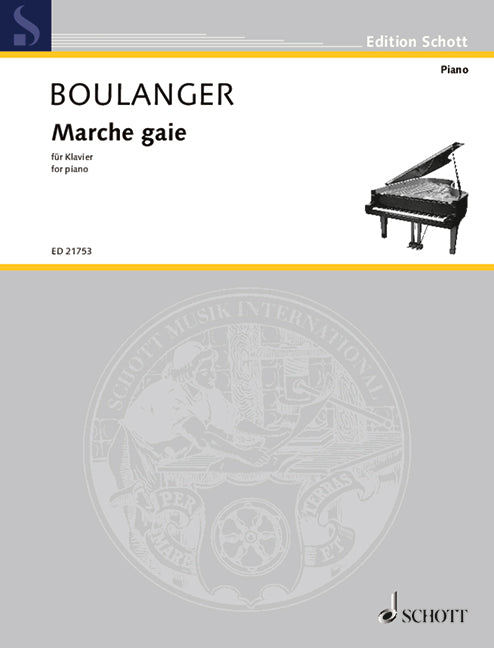L. Boulanger: Marche gaie (arr. for piano)
In stock and typically ships within 1 business day.
- Composer: Lili Boulanger (1893-1918)
- Arranger: Caroline Potter
- Instrumentation (this edition): Piano
- Originally for: Chamber Orchestra
- Work: Marche gaie
- ISMN:
- Size: 9.1 x 11.9 inches
- Pages: 16
Description
In her all too brief career, Lili Boulanger (1893-1918) composed a number of works whose existence is unquestioned for which there is proof they existed but which have now disappeared. One of these missing pieces, Marche gaie , resurfaced in short score form in 2011 in a private collection in North Carolina; the owners of the manuscript are the grandchildren of the work's dedicatee, Jeanne Leygues. As Marche gaie was registered with SACEM (the collecting Society for music in France) as a work for chamber orchestra in 1916, we can assume it was composed in that year. While the manuscript is in an unknown hand, there is musical and circumstantial evidence, combined with testimony from the family (whose Leygues ancestors knew the Boulanger family well), that shows beyond reasonable doubt that this is a missing work by Lili Boulanger.
Jeanne Leygues, daughter of the French politician Georges Leygues, briefly Prime Minister in 1920-1 and a great supporter of the arts, married an American, Paul Rockwell, who fought with his brother in the French Foreign Legion in World War I. We can assume that Marche gaie was commissioned for Jeanne's wedding in December 1916, not least because the piece alludes to Mendelssohn's famous Wedding March in bars 25-32, a gesture typical of Lili Boulanger, who was fond of quotation and allusion. Marche gaie was originally paired with a Marche funèbre , a work yet to resurface.
It is a pleasure to bring this occasional piece to life. The author is very grateful to Paul Sholar and Vance Brown, of Asheville, North Carolina, for their generous assistance in preparing Marche gaie for publication.
-Caroline Potter
Publishers use a lot of words to describe what they sell, and we know it can be confusing. We've tried to be as clear as possible to make sure you get exactly what you are looking for. Below are descriptions of the terms that we use to describe the various formats that music often comes in.
Choral Score
A score for vocalists that only contains the vocal lines. The instrumental parts are not there for reference. Generally, cheaper than a vocal score and requires multiple copies for purchase.
Facsimile
Reproductions of the original hand-written scores from the composer.
Full Score
For ensemble music, this indicates that the edition contains all parts on a single system (there are not separate parts for each player). In larger ensembles, this is for the conductor.
Hardcover
Hardbound. Generally either linen-covered or half-leather.
Orchestral Parts
Similar to a wind set, this is a collection of parts. In the case of strings, the numbers listed are the number of copies included, though generally these are available individually (often with minimum quantities required).
Paperback
When publishers offer multiple bindings (e.g. hardcover) or study scores, this is the "standard" version. If you're planning to play the music, this is probably what you want.
Performance / Playing Score
A score of the music containing all parts on one system, intended for players to share. There are not separate parts for each player.
Set of Parts
For ensemble music, this indicates that there are separate individual parts for each player.
Solo Part with Piano Reduction
For solo pieces with orchestra, this is a version that contains a piano reduction of the orchestra parts. For piano pieces, two copies are typically needed for performance.
Study Score
A small (think choral size) copy of the complete score meant for studying, and not playing. They make great add-ons when learning concertos and small chamber works.
Vocal Score
A score prepared for vocalists that includes the piano/organ part or a reduction of the instrumental parts.
Wind Set
For orchestral music, this is a collection of wind and percussion parts. The specific quantities of each instrument are notated.
With Audio
In addition to the printed music, the edition contains recordings of the pieces. This may be an included CD, or access to files on the internet.
With / Without Fingering (Markings)
Some publishers prepare two copies - a pure Urtext edition that includes no fingering (or bowing) suggestions and a lightly edited version that includes a minimal number of editorial markings.


